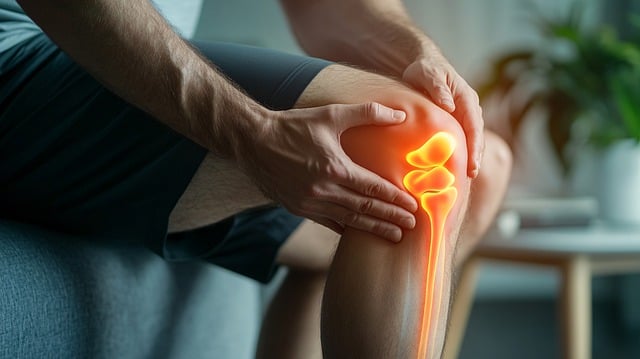If you’ve been struggling with chronic joint pain and want to explore a natural solution, Platelet-Rich Plasma (PRP) therapy might be exactly what you’re looking for. This cutting-edge, non-surgical treatment has gained significant popularity in recent years for its ability to harness the body’s natural healing processes, providing relief and promoting tissue repair without the need for invasive procedures. Here’s an in-depth look at why PRP therapy could be the solution for managing your joint pain naturally and effectively.

Table of Contents
ToggleWhat is Platelet-Rich Plasma (PRP) Therapy?
PRP therapy is a regenerative treatment that uses a patient’s own blood to promote healing and tissue regeneration. The process begins with a blood draw, from which the platelets—cells that help with clotting and healing—are extracted and concentrated. These platelets are rich in growth factors, proteins, and other components that stimulate tissue repair. After concentrating the platelets, they are injected into the injured or painful joint, where they help promote healing, reduce inflammation, and speed up recovery.
PRP is often used as a natural alternative to surgery or long-term use of medication for conditions such as osteoarthritis, tendon injuries, ligament sprains, and even chronic joint pain. It is especially popular among those who prefer to avoid invasive treatments and want to explore a more holistic, body-centered solution to their pain.
1. Natural Healing: Utilizing Your Body’s Own Resources
One of the most attractive aspects of PRP therapy is its use of your body’s own healing abilities. The treatment involves processing a small amount of your blood to concentrate the platelets, which are then injected back into your body. This means that the healing factors—such as growth factors, cytokines, and other bioactive proteins—are your own, making the process highly personalized and natural.
Because PRP uses the body’s own resources, it is considered a biologic treatment, and there is minimal risk of rejection or allergic reactions. The growth factors in the PRP stimulate cells to repair and regenerate damaged tissues, making it a highly effective treatment for joint conditions like osteoarthritis, tendinitis, and cartilage degeneration.
2. Reduced Inflammation: A Key to Managing Chronic Pain
Joint pain is often accompanied by inflammation, which can worsen symptoms and delay healing. One of the primary benefits of PRP is its ability to reduce inflammation. The growth factors in PRP injections promote the release of anti-inflammatory proteins that help alleviate swelling and pain, allowing for more comfortable movement.
In conditions like osteoarthritis, where cartilage breakdown leads to painful bone-on-bone contact, inflammation is a significant factor that exacerbates the pain. By reducing this inflammation, PRP helps to not only alleviate immediate discomfort but also reduce the likelihood of further joint damage.
3. Pain Relief: A Non-Surgical Solution
Pain management is a critical aspect of treating joint conditions. While traditional treatments like pain medications or corticosteroid injections can offer temporary relief, they do not address the root cause of the pain. PRP, on the other hand, actively promotes the healing of tissues, reducing pain at its source.
By stimulating collagen production and tissue repair, PRP helps to restore the structural integrity of joints, tendons, and ligaments. Over time, this can lead to sustained pain relief. In fact, many patients experience long-lasting pain reduction after just a few sessions of PRP therapy.
4. A Non-Surgical Option: Avoiding the Risks of Invasive Procedures
For those facing chronic joint pain, surgery is often considered the last resort. However, surgery carries inherent risks, including infections, long recovery times, and the potential for complications. PRP offers a non-surgical alternative that can provide significant pain relief and healing without the need for invasive procedures.
Since PRP injections are minimally invasive, they involve far less risk than joint surgery. The procedure typically takes less than an hour, with little to no downtime. Most patients are able to resume their regular activities within a day or two, depending on the severity of their condition.
5. Quick Recovery: Get Back to Your Routine Faster
One of the major advantages of PRP therapy over traditional surgery is the relatively quick recovery time. While recovery from surgery can take weeks or even months, PRP typically involves little downtime. This makes it a convenient option for those with active lifestyles who want to get back to their daily routines as quickly as possible.
PRP therapy is also beneficial because it accelerates tissue healing, reducing the time it takes to recover from injuries and inflammation. Many patients report noticeable improvements in mobility and pain relief within a few weeks of treatment.
6. Long-Lasting Results: Enjoy Relief for Months or Even Years
While the results of PRP therapy can vary from patient to patient, many individuals experience long-lasting relief after treatment. Some studies show that patients who undergo PRP injections may enjoy pain relief and improved joint function for up to a year or more. For chronic conditions like osteoarthritis, where degeneration is progressive, PRP can slow the disease’s progression and reduce the need for more invasive treatments.
Although PRP isn’t a permanent cure, it can provide prolonged relief, which makes it an attractive option for people looking for long-term management of joint pain. In some cases, the effects of PRP injections may last so long that additional treatments aren’t needed for many months or years.
7. Versatility: Treats Various Joint Conditions
PRP is highly versatile and can be used to treat a range of joint-related issues. Whether you’re dealing with osteoarthritis, tendonitis, or ligament sprains, PRP has been shown to be effective in treating a variety of conditions. It can be used in joints such as the knees, hips, shoulders, elbows, and ankles.
For example, athletes who suffer from sports-related injuries like tennis elbow or rotator cuff tears may benefit from PRP as it promotes quicker healing of damaged tendons and ligaments. PRP also plays a significant role in treating cartilage damage and degenerative conditions like osteoarthritis by stimulating the regeneration of damaged cartilage.
8. Delays or Avoids Surgery: A Preventative Approach
For many people suffering from chronic joint pain, surgery may seem like the only option left. PRP can potentially delay or even avoid the need for surgery altogether. By promoting healing and regeneration, PRP helps to restore joint function and reduce the pain associated with degeneration or injury, making it possible to postpone more invasive treatments like joint replacement.
In fact, studies show that PRP therapy may reduce the need for surgery in patients with conditions like osteoarthritis or tendonitis, as it helps to slow the progression of joint damage and restore function.
Considerations and Potential Side Effects
While PRP therapy has been proven to be safe and effective for many patients, it’s important to note that results can vary depending on the individual and the specific condition being treated. Some people may experience temporary swelling or bruising at the injection site, but serious side effects are rare. Since PRP uses your own blood, the risk of infection or allergic reaction is extremely low.
It’s also worth mentioning that PRP therapy may not work for everyone. The effectiveness of the treatment depends on factors such as the severity of the condition, the location of the injury, and the patient’s overall health.
Is PRP Therapy Right for You?
If you’re considering PRP therapy for your joint pain, it’s important to consult with a healthcare provider who specializes in regenerative medicine. They can assess your condition, discuss your treatment options, and determine if PRP therapy is the best course of action for you.
PRP therapy can be a highly effective solution for managing chronic joint pain, offering natural healing, pain relief, and the potential to avoid surgery. With its minimal risks and quick recovery time, it’s no wonder that PRP has become a go-to treatment for people seeking a non-invasive, long-lasting solution to joint pain.
By tapping into the body’s natural healing potential, PRP therapy represents a significant step forward in the treatment of joint pain and injuries. Whether you’re dealing with osteoarthritis, tendon injuries, or ligament sprains, PRP can provide a promising alternative to traditional treatments, allowing you to enjoy an active, pain-free lifestyle without the need for surgery.
Experience Relief From Joint Pain With PRP Therapy in Tempe, Arizona, At The Strength Doctor
Are you struggling with joint pain and seeking a proven treatment to support your recovery and enhance your quality of life? At The Strength Doctor, PRP (Platelet-Rich Plasma) Therapy is designed to work in harmony with your body’s natural healing processes, offering effective relief and improved joint function. This cutting-edge therapy helps reduce pain, promote tissue repair, and maximize your body’s ability to heal itself.
What sets this care apart is Dr. Clark’s dedication to your long-term health and recovery. With personalized attention, Dr. Clark crafts a PRP therapy plan tailored specifically to your needs and goals. Each treatment is informed by a comprehensive health evaluation, giving you the tools to make empowered decisions about your wellness journey. The Strength Doctor’s services reflect a commitment to the highest standards of care, ensuring you experience lasting results.
Are you ready to reclaim a life free from joint pain? Discover the transformative benefits of PRP Therapy with The Strength Doctor in Tempe, Arizona. Contact us today to schedule your consultation and take the first step toward optimal joint health and vitality. Don’t wait—let The Strength Doctor guide you toward lasting relief!
Disclaimer
The materials available on this website are for informational and entertainment purposes only and not to provide medical or legal advice. You should contact your physician and attorney for advice concerning any particular issue or problem. You should not act or refrain from acting based on any content included in this site without seeking legal or other professional medical advice. The information presented on this website may reflect only some current legal or medical developments. No action should be taken in reliance on the information on this website. We disclaim all liability concerning actions taken or not taken based on any or all of the contents of this site to the fullest extent permitted by law.
